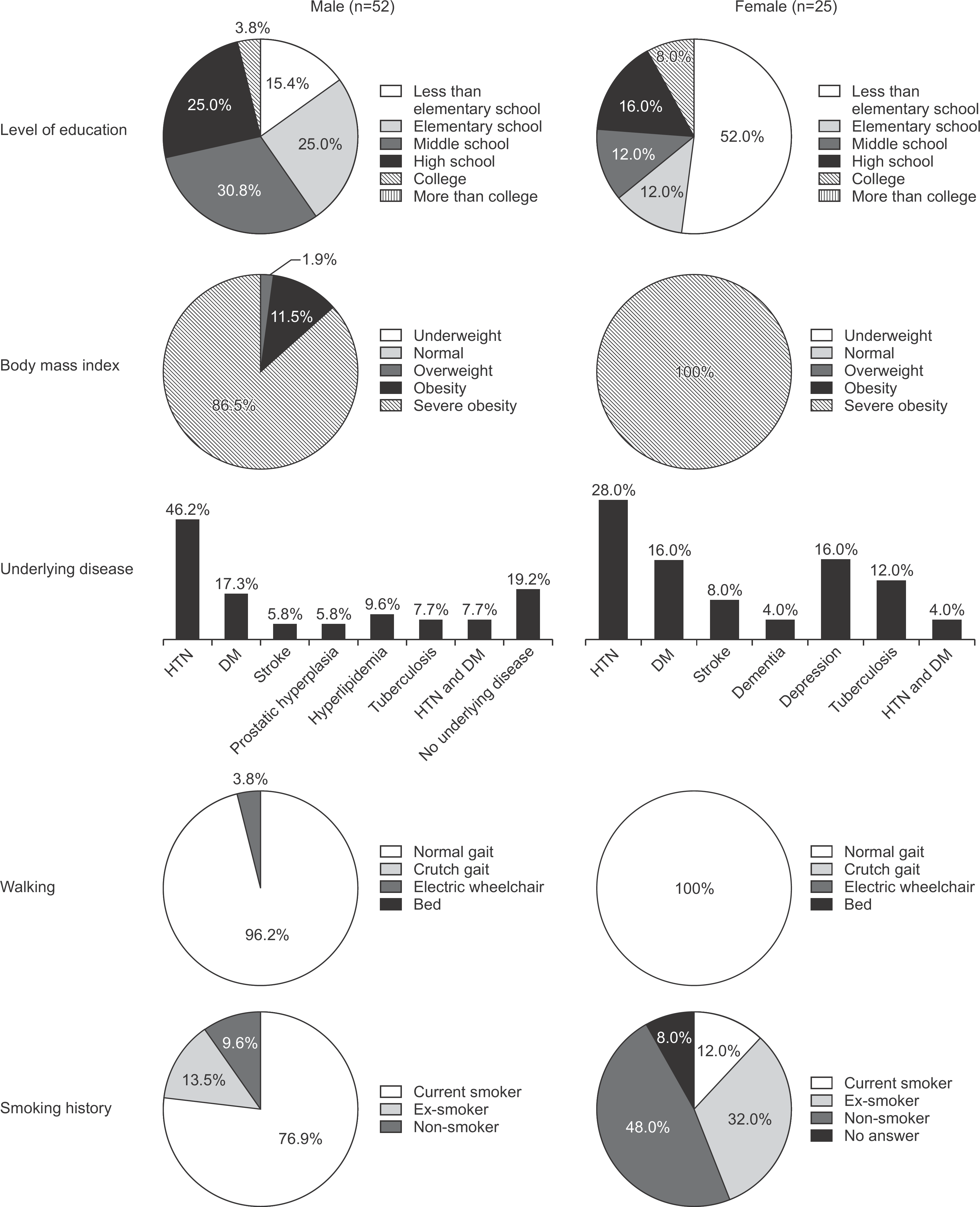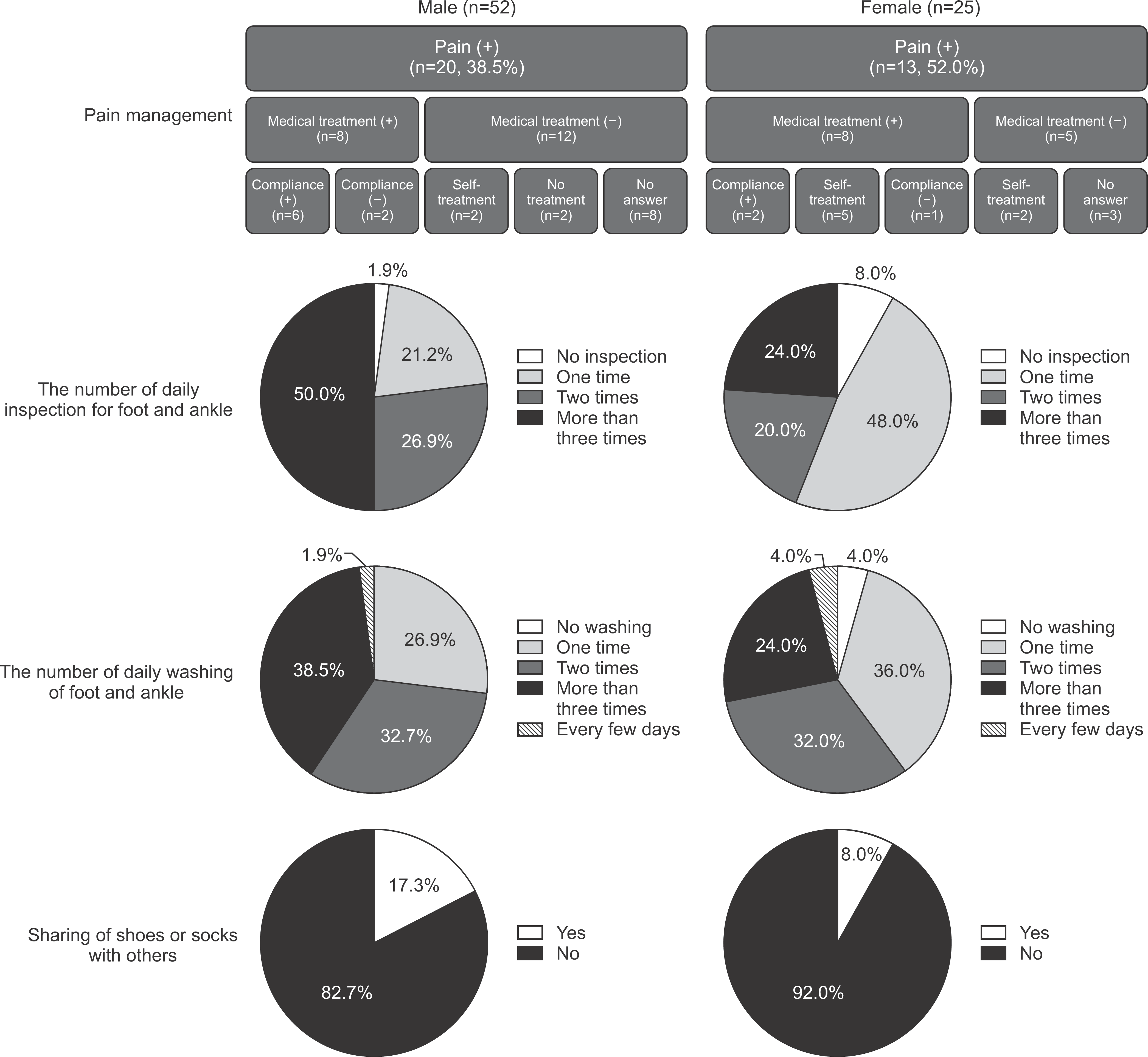Abstract
Purpose:
Foot and ankle disease (FAD) is a frequent cause of morbidity among the homeless population. Various conditions, exacerbated by malnutrition, poor lifestyle habits, psychiatric disorders, physical injuries, poor hygiene, and limited access to healthcare, have been described in this population. The purpose of this study was to investigate the cognition and management status of FAD in shelter-based homeless people.
Materials and Methods:
Fifty-two male and twenty-five female volunteer homeless individuals were recruited from two homeless shelters. Each person completed a questionnaire assessing any presence of pain, pain management, as well as foot and ankle care status. A foot and ankle surgeon examined the physical status of the individual’s foot and ankle, including tenderness and instability. A radiologic evaluation was done for 18 male and 11 female homeless people who agreed to participate in this test for the existence osteophyte or joint space narrowing representing osteoarthritis and some reference angles for hallux valgus, flatfoot and cavus foot.
REFERENCES
1.Nam KC. Social welfare and housing service for the homeless in Korea1 J Crit Soc Policy1. 2011. 31:121–591.
2.Kang DJ., Kim DH., Kim JS., Kim TH., Park YA., Yu WS. Current status and problem in the homeless medicare system [Internet]1. Seoul: People’s Health Institute;2015. [cited 2017 Jun 30]1 Available from:. http://health1re1kr/wp-content/up-loads/2015/11/20151120_0604571pdf1.
3.Ministry of Health and Welfare. The homeless welfare guidance in 2017 [Internet]1 Sejong: Ministry of Health and Welfare. 2017. [cited 2017 Jun 30]1 Available from:. http://download1mohw1go1kr/front_new/modules/download1jsp?BOARD_ID=5900&CONT_SEQ=338726&FILE_SEQ=2038421.
4.Chen B., Mitchell A., Tran D. “Step up for foot care”: addressing podiatric care needs in a sample homeless population1 J Am Po-diatr Med Assoc1. 2014. 104:269–761.
5.Raoult D., Foucault C., Brouqui P. Infections in the homeless1 Lancet Infect Dis1. 2001. 1:77–841.
6.Segal SP., Gomory T., Silverman CJ. Health status of homeless and marginally housed users of mental health self-help agencies1 Health Soc Work1. 1998. 23:45–521.
7.Wrenn K. Foot problems in homeless persons1 Ann Intern Med1. 1990. 113:567–91.
8.Hwang SW., Lebow JM., Bierer MF., O’Connell JJ., Orav EJ., Brennan TA. Risk factors for death in homeless adults in Boston1 Arch Intern Med1. 1998. 158:1454–601.
9.Kleinman LC., Freeman H., Perlman J., Gelberg L. Homing in on the homeless: assessing the physical health of homeless adults in Los Angeles County using an original method to obtain physical examination data in a survey1 Health Serv Res1. 1996. 31:533–491.
10.Moy JA., Sanchez MR. The cutaneous manifestations of violence and poverty1 Arch Dermatol1. 1992. 128:829–391.
11.WHO Expert Consultation. Appropriate body-mass index for Asian populations and its implications for policy and intervention strategies1 Lancet1. 2004. 363:157–631.
13.Wlodarczyk D., Prentice R. Health issues of homeless persons1 West J Med1. 1988. 148:717–91.
14.Robbins JM., Roth LS., Villanueva MC. “Stand down for the home-less”1 Podiatric screening of a homeless population in Cleveland1 J Am Podiatr Med Assoc1. 1996. 86:275–91.
15.Stratigos AJ., Stern R., González E., Johnson RA., O’Connell J., Dover JS. Prevalence of skin disease in a cohort of shelter-based homeless men1 J Am Acad Dermatol1. 1999. 41:197–2021.
16.OECD. Health at a glance 2015: OECD indicators1 Paris: OECD Publishing. 20151. p1691.
17.Dufour AB., Losina E., Menz HB., LaValley MP., Hannan MT. Obesity, foot pain and foot disorders in older men and women1 Obes Res Clin Pract1. 2017. 11:445–531.
18.Frey C., Zamora J. The effects of obesity on orthopaedic foot and ankle pathology1 Foot Ankle Int1. 2007. 28:996–91.
19.Perruccio AV., Gandhi R., Lau JT., Syed KA., Mahomed NN., Ramp-ersaud YR. Cross-sectional contrast between individuals with foot/ankle vs knee osteoarthritis for obesity and low education on health-related quality of life1 Foot Ankle Int1. 2016. 37:24–321. 201 Thorud JC, Mortensen S, Thorud JL, Shibuya N, Maldonado YM, Jupiter DC. Effect of obesity on bone healing after foot and ankle long bone fractures1 J Foot Ankle Surg1 2017;56: 258-621.
21.Vela SA., Lavery LA., Armstrong DG., Anaim AA. The effect of increased weight on peak pressures: implications for obesity and diabetic foot pathology1 J Foot Ankle Surg1. 1998. 37:416–20. discussion 448-91.
22.Lu JT., Creager MA. The relationship of cigarette smoking to peripheral arterial disease1 Rev Cardiovasc Med1. 2004. 5:189–931.
24.Nam KC., Shin WW., Min SY., Kim SM., Kim JH., Lee JH. Program and manual development for welfare institution for the home-less1 Sejong: Ministry of Health and Welfare. 20131.
25.Watanabe S., Harada T., Hiruma M., Iozumi K., Katoh T., Mochizuki T, et al. Japan Foot Week Group. Epidemiological survey of foot diseases in Japan: results of 30,000 foot checks by dermatolo-gists1 J Dermatol1. 2010. 37:397–4061.
Table 1.
Visual Examination
Table 2.
Physical Examination
| Variable | Male (n=52) | Female (n=25) |
|---|---|---|
| Tenderness | ||
| Ankle | 7 (13.5) | 7 (28.0) |
| Hindfoot | - | 1 (4.0) |
| Midfoot | 2 (3.8) | 5 (20.0) |
| Forefoot | 3 (5.8) | 2 (8.0) |
| Stress test | ||
| Anterior drawer test 13 (25.0) 9 (36.0) | ||
Table 3.
Radiologic Evaluation




 PDF
PDF ePub
ePub Citation
Citation Print
Print




 XML Download
XML Download